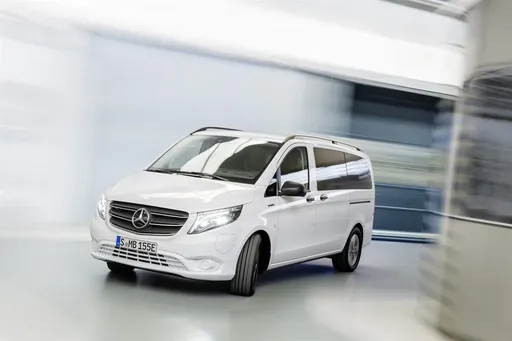Mercedes Vito Bus vs VW Crafter - Differences and prices compared
Costs and Efficiency:
When it comes to price and running costs, the biggest differences usually appear. This is often where you see which car fits your budget better in the long run.
Mercedes Vito Bus has a evident advantage in terms of price – it starts at 36300 £, while the VW Crafter costs 47100 £. That’s a price difference of around 10794 £.
Fuel consumption also shows a difference: Mercedes Vito Bus manages with 6.70 L and is therefore evident more efficient than the VW Crafter with 8.40 L. The difference is about 1.70 L per 100 km.
Engine and Performance:
Power, torque and acceleration are the classic benchmarks for car enthusiasts – and here, some clear differences start to show.
When it comes to engine power, the Mercedes Vito Bus has a noticeable edge – offering 237 HP compared to 177 HP. That’s roughly 60 HP more horsepower.
In terms of top speed, the VW Crafter performs to a small extent better – reaching 165 km/h, while the Mercedes Vito Bus tops out at 140 km/h. The difference is around 25 km/h.
There’s also a difference in torque: Mercedes Vito Bus pulls to a small extent stronger with 500 Nm compared to 410 Nm. That’s about 90 Nm difference.
Space and Everyday Use:
Whether family car or daily driver – which one offers more room, flexibility and comfort?
Seats: Mercedes Vito Bus offers clearly more seating capacity – 8 vs 2.
In curb weight, Mercedes Vito Bus is hardly perceptible lighter – 2023 kg compared to 2072 kg. The difference is around 49 kg.
In maximum load capacity, the VW Crafter performs convincingly better – up to 18400 L, which is about 13410 L more than the Mercedes Vito Bus.
When it comes to payload, VW Crafter decisively takes the win – 2994 kg compared to 1077 kg. That’s a difference of about 1917 kg.
Who wins the race?
The Mercedes Vito Bus proves to be outperforms in nearly all aspects and therefore becomes our DriveDuel Champion!
Mercedes Vito Bus is the better all-rounder in this comparison.
 @ Mercedes-Benz Group Media
@ Mercedes-Benz Group Media
Mercedes Vito Bus
Costs and Consumption
View detailed analysis
Engine and Performance
View detailed analysis
Dimensions and Body
View detailed analysis
Mercedes Vito Bus
The Mercedes Vito is a sturdy, no-nonsense people carrier that blends commercial practicality with a surprisingly civilised cabin, making long shuttles feel less like a chore. If you need a dependable transporter that swallows luggage, forgives hard use and still looks a touch more premium than a plain van, the Vito is an easy, sensible pick.
details @ Mercedes-Benz Group Media
@ Mercedes-Benz Group Media
VW Crafter
The VW Crafter is a no-nonsense workhorse that makes hauling and running a mobile business feel almost civilized, with a cabin built for long days and smart storage where you need it. It may not turn heads for glamour, but its sturdy build, straightforward tech and reliable manners mean fewer headaches for owners — a van that prefers to earn your trust rather than demand attention.
details
 @ Mercedes-Benz Group Media
@ Mercedes-Benz Group Media
|
|
|
|
|
Costs and Consumption |
|
|---|---|
|
Price
36300 - 55900 £
|
Price
47100 - 68800 £
|
|
Consumption L/100km
6.7 - 10 L
|
Consumption L/100km
8.4 - 13.1 L
|
|
Consumption kWh/100km
26.7 - 26.9 kWh
|
Consumption kWh/100km
-
|
|
Electric Range
248 - 370 km
|
Electric Range
-
|
|
Battery Capacity
60 - 90 kWh
|
Battery Capacity
-
|
|
co2
0 - 228 g/km
|
co2
220 - 342 g/km
|
|
Fuel tank capacity
57 - 70 L
|
Fuel tank capacity
75 L
|
Dimensions and Body |
|
|---|---|
|
Body Type
Bus
|
Body Type
Cargo Van
|
|
Seats
8
|
Seats
2
|
|
Doors
4
|
Doors
4
|
|
Curb weight
2023 - 2739 kg
|
Curb weight
2072 - 2810 kg
|
|
Trunk capacity
580 - 1390 L
|
Trunk capacity
-
|
|
Length
4895 - 5370 mm
|
Length
5986 - 7391 mm
|
|
Width
1928 mm
|
Width
2040 - 2069 mm
|
|
Height
1890 mm
|
Height
2355 - 2830 mm
|
|
Max trunk capacity
4190 - 4990 L
|
Max trunk capacity
9300 - 18400 L
|
|
Payload
726 - 1077 kg
|
Payload
1037 - 2994 kg
|
Engine and Performance |
|
|---|---|
|
Engine Type
Diesel, Electric, Petrol
|
Engine Type
Diesel
|
|
Transmission
Automatic
|
Transmission
Manuel, Automatic
|
|
Transmission Detail
Automatic Gearbox, Reduction Gearbox
|
Transmission Detail
Manual Gearbox, Automatic Gearbox
|
|
Drive Type
Rear-Wheel Drive, All-Wheel Drive, Front-Wheel Drive
|
Drive Type
Rear-Wheel Drive, Front-Wheel Drive, All-Wheel Drive
|
|
Power HP
136 - 237 HP
|
Power HP
140 - 177 HP
|
|
Acceleration 0-100km/h
-
|
Acceleration 0-100km/h
-
|
|
Max Speed
140 km/h
|
Max Speed
90 - 165 km/h
|
|
Torque
330 - 500 Nm
|
Torque
360 - 410 Nm
|
|
Number of Cylinders
4
|
Number of Cylinders
4
|
|
Power kW
100 - 174 kW
|
Power kW
103 - 130 kW
|
|
Engine capacity
1950 - 1999 cm3
|
Engine capacity
1968 cm3
|
General |
|
|---|---|
|
Model Year
2024
|
Model Year
2017 - 2023
|
|
CO2 Efficiency Class
G, A
|
CO2 Efficiency Class
G
|
|
Brand
Mercedes-Benz
|
Brand
VW
|
What drive types are available for the Mercedes Vito Bus?
The Mercedes Vito Bus is offered with Rear-Wheel Drive, All-Wheel Drive or Front-Wheel Drive.
The prices and data displayed are estimates based on German list prices and may vary by country. This information is not legally binding.
